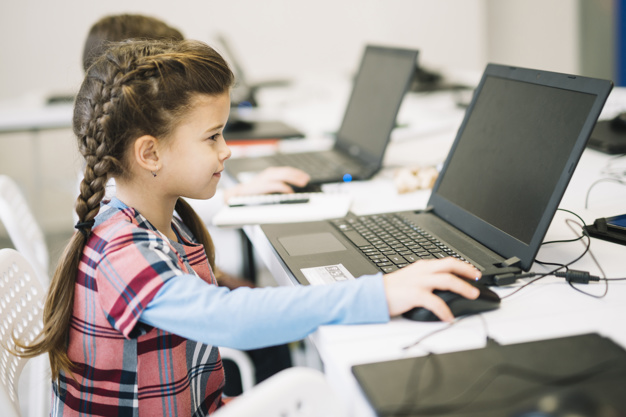Only A Few Spaces Left For Our Premier VPK Program! We Are Now Enrolling & Would Love to Meet You & Your Family!
Get More Information About Our VPK Program: Click Here
From the time of birth until eight years of age, children reach a number of developmental milestones that set the foundation for their adult life. From language to social, emotional and intellectual development, every encounter and activity— use of technology being one—offers a unique learning experience.
The advancements in recent years have encouraged computer learning in children at ages as early as just a few months. Educational technology has become the key driver of enriched academic learning and intelligent tutoring. But does it have a place in preschool and school curriculum? Let’s take a look!
Researchers, educators and policymakers; everyone’s interested in redefining the early childhood curriculum for streamlined and effective learning programs. How technology fits in the equation depends on the end goals and objectives that early childhood education is hoping to achieve.

To figure out whether technology and computers are developmentally appropriate, we need to keep in mind a multitude of factors; learning style is one of them.
Research shows that children aged three and above need a variety of experiences to broaden their understanding and learn appropriate behaviors. With traditional teacher-directed learning losing its efficacy, it’s important to be open to new approaches especially for children born in the digital era.
An important argument against the integration of technology in early childhood education is the danger of various other developmental needs not met. Physical and sensory play, exploration, interest in arts and music is at risk of being compromised, but what many fail to consider is the strategic implementation of technology in the curriculum.
Modern early childhood curriculums are being designed to promote educational technology just as much as practical life skills or play-based learning. The purpose is to improve children’s educational development rather than teaching them the use of technology and risking a decline in other developmental areas.
At elementary and middle school level, educational technology serves a different purpose. It offers tailored learning experience in an immersive environment while minimizing classroom time.

Students can use technology to learn advanced problem-solving skills, adapt to new learning models and perform science experiments through cloud access.
Technology is especially imperative for STEM learning, particularly in fields of math and science. Mathematic apps and software have proven to increase student’s knowledge of math problems and achievement in the field.
The ability to positively impact learning stems from the right use of technology. Let’s take a look at few techniques that can make for the effective integration of technology in school education.
The application of educational technology in the classroom is endless. From the use of software to create tests, books, illustrations to its use for graphic application, adaptive learning and research, the opportunities are endless—but need to be carefully integrated into the curriculum.
Whether we like it or not, in the digital era, it’s impossible to keep children away from phones an tablets. Even if the school curriculum doesn’t adopt educational technology and computer learning, children learn this at home.
What’s important is the right and directed use where children are able to collaborate with their peers, address issues regarding material—for learning—shortage and ease the burden of complicated academic curriculum. There are a number of ways classrooms can implement technology to transform traditional approaches to instruction-based learning. But further policy change is required.
Studies have shown that the positive impact of technology is heavily dependent on the implementation technique by the teacher. When the teacher was able to use a holistic learning model using technology, students’ performance overall and on test scores increased.
In early childhood education, it’s important to note that every child’s developmental growth varies; and the difference only grows during the first years of schools. This gap is especially evident for children who belong to economically disadvantaged communities and don’t have access to the same privileges and experiences.
To ensure that parents and schools aren’t pushing these children beyond their limits, carefully designed curriculums—at every level—that cater to the individual needs of every child are becoming the need of the hour.

At Kids R Kids, we believe in blended learning where children are introduced to new programs and courses as they show readiness. Using a multitude of learning techniques, we offer an enriching environment where every child is able to build upon their education with the use of technology and STEM learning.
Our STEM-based activities and G.Y.M curriculum® “Growing Young Minds” provides an ideal environment for experience-based learning. To know more about the program, continue reading here.
You can also get in touch with and enroll your child by filling this application form. We are one of the leading daycare and preschool academy based in Orlando, Florida.